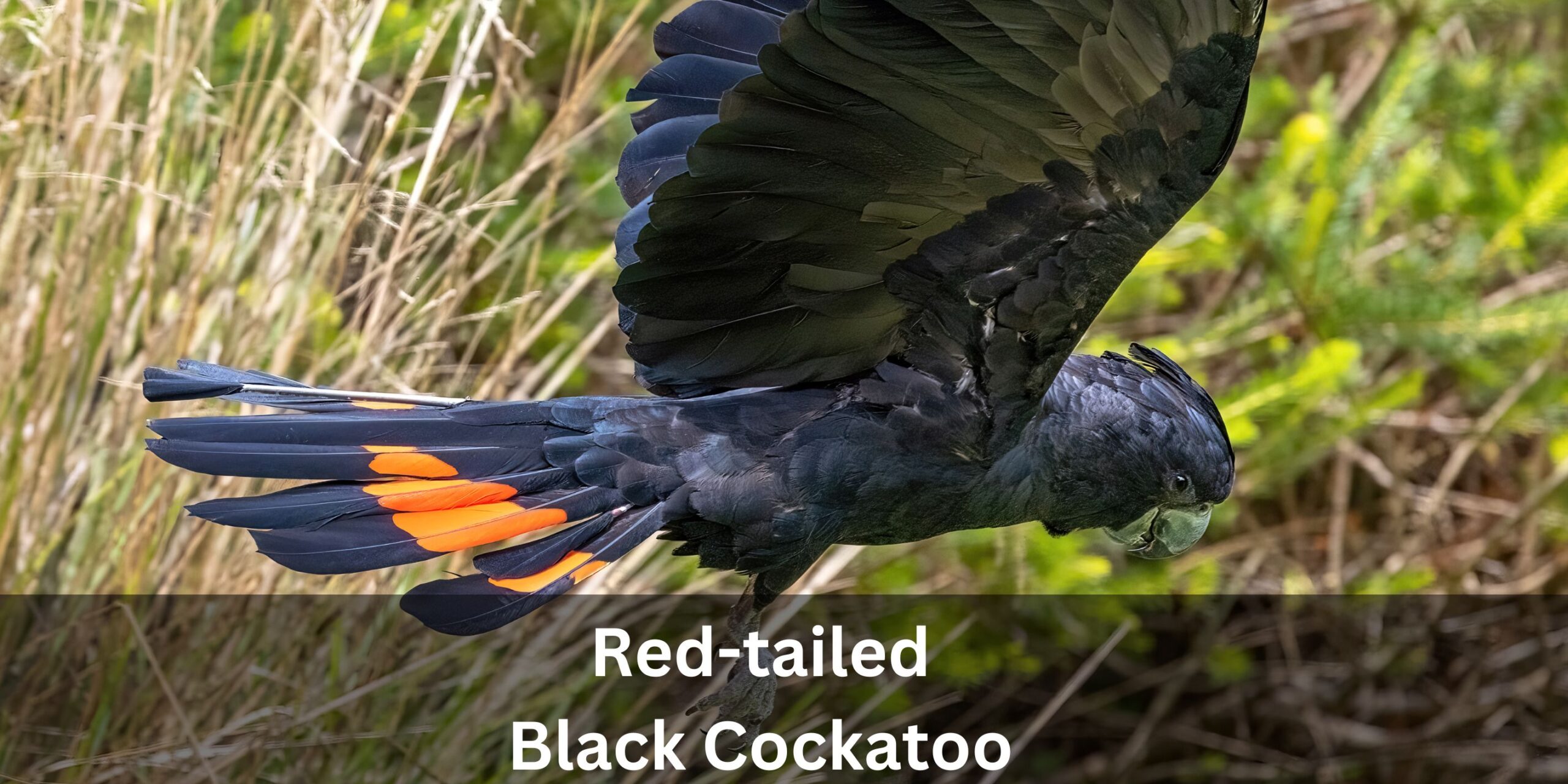Red-tailed Black Cockatoo
The Magnificent Red-Tailed Black Cockatoo
The Red-tailed Black Cockatoo (Calyptorhynchus banksii) is a large iconic parrot native to Australia. With its striking jet-black plumage and bold red tail bands, it is an unmistakable sight soaring across Australia’s woodlands.
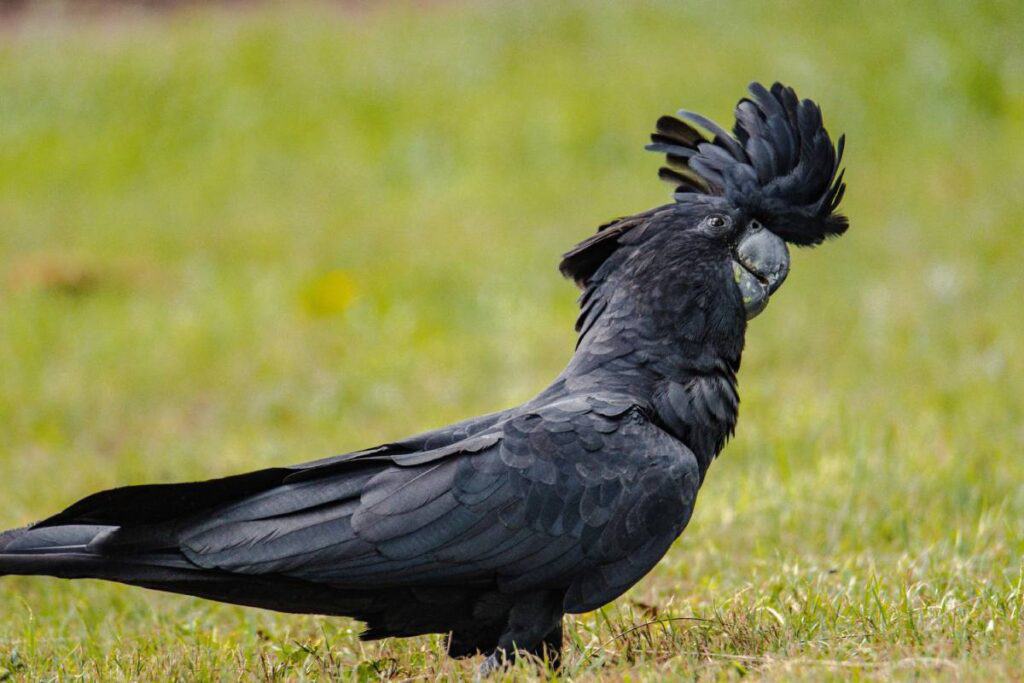
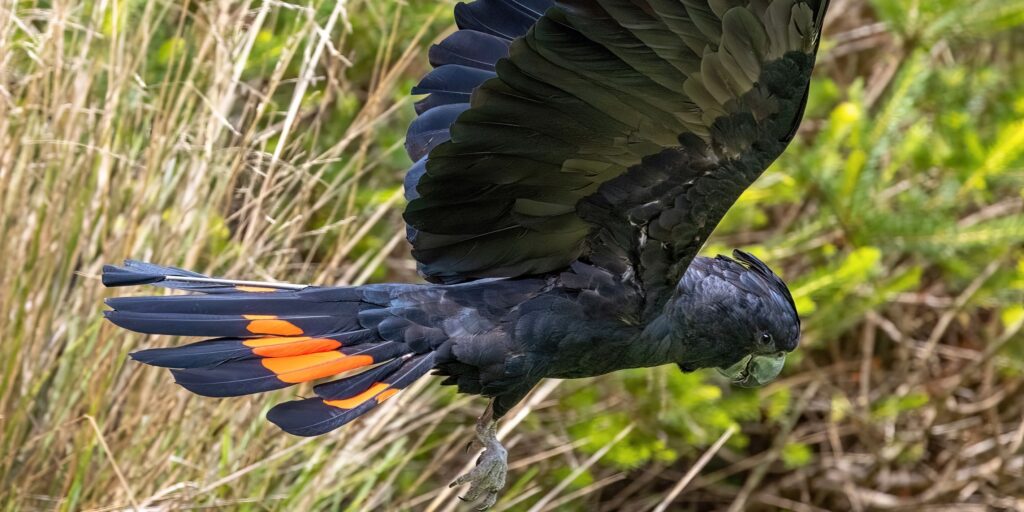
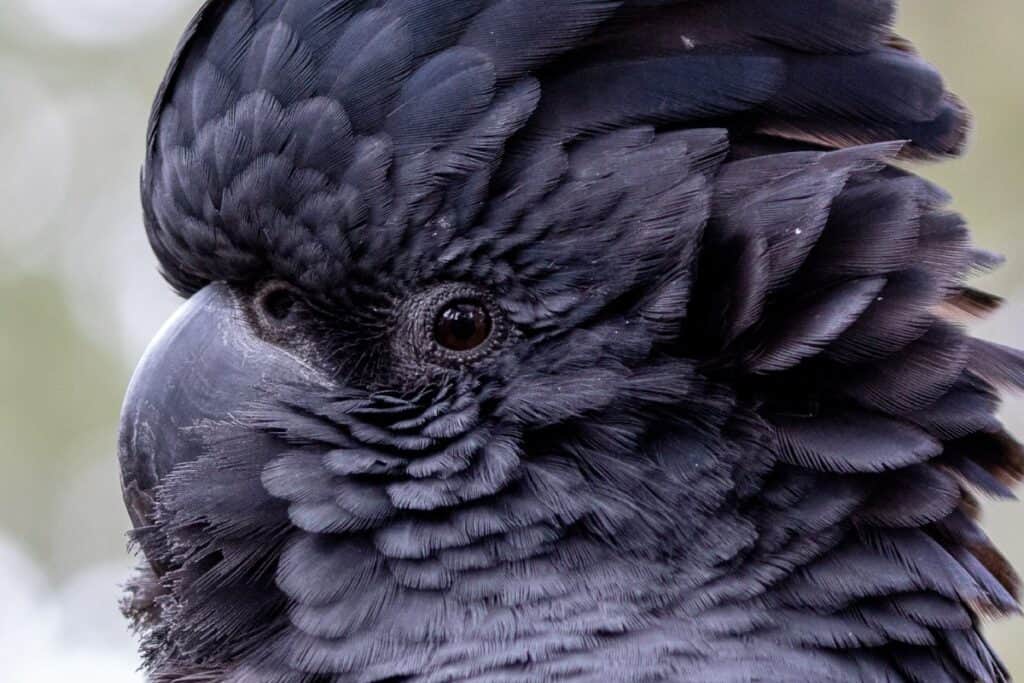
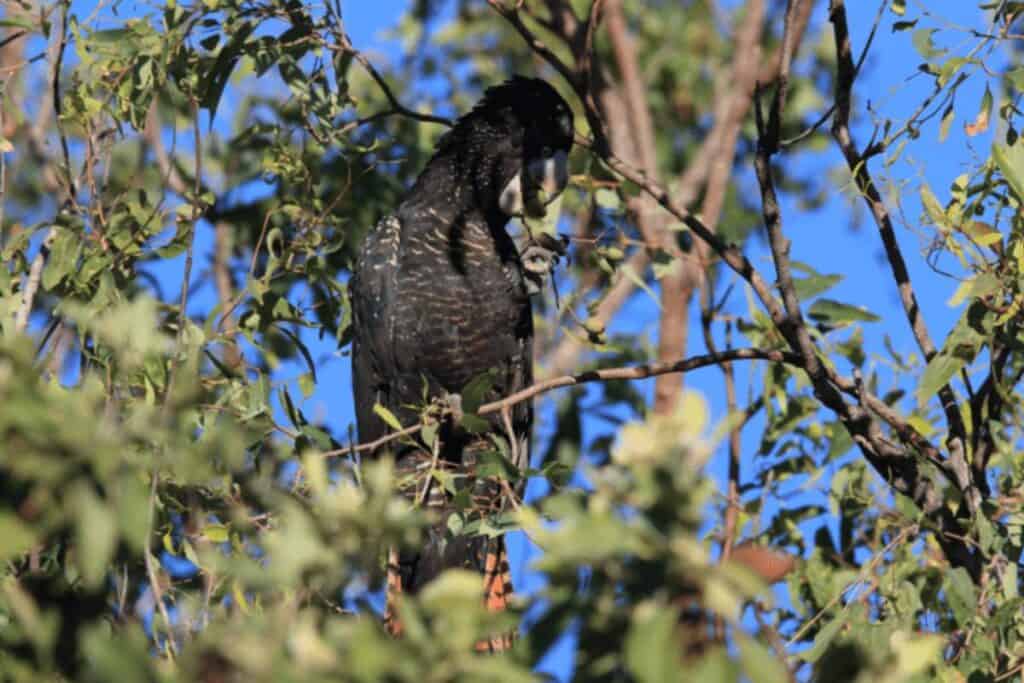
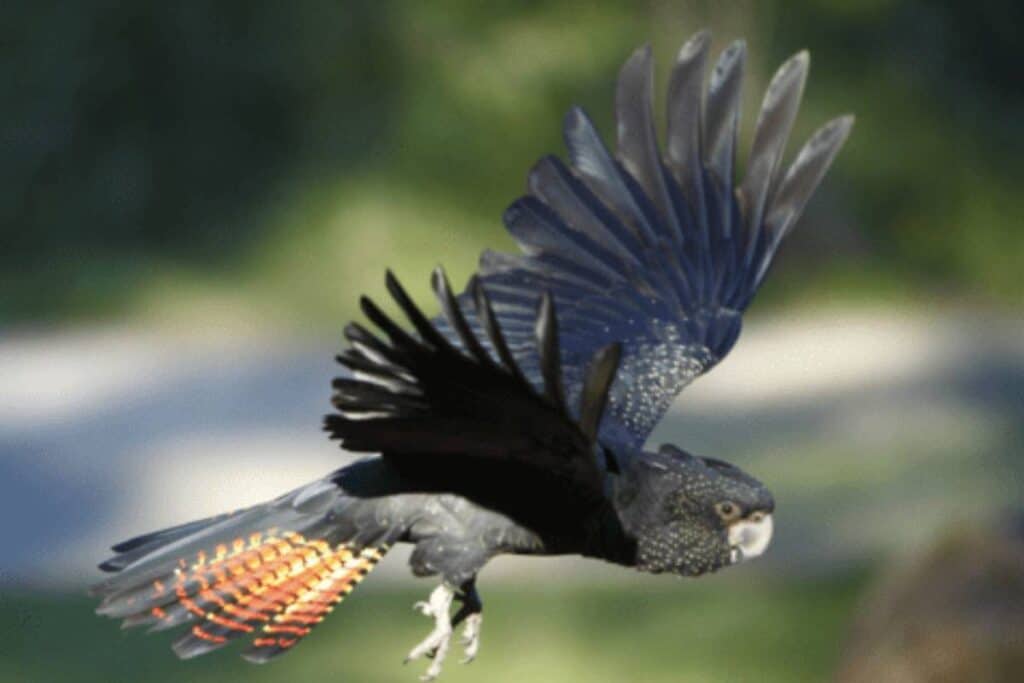
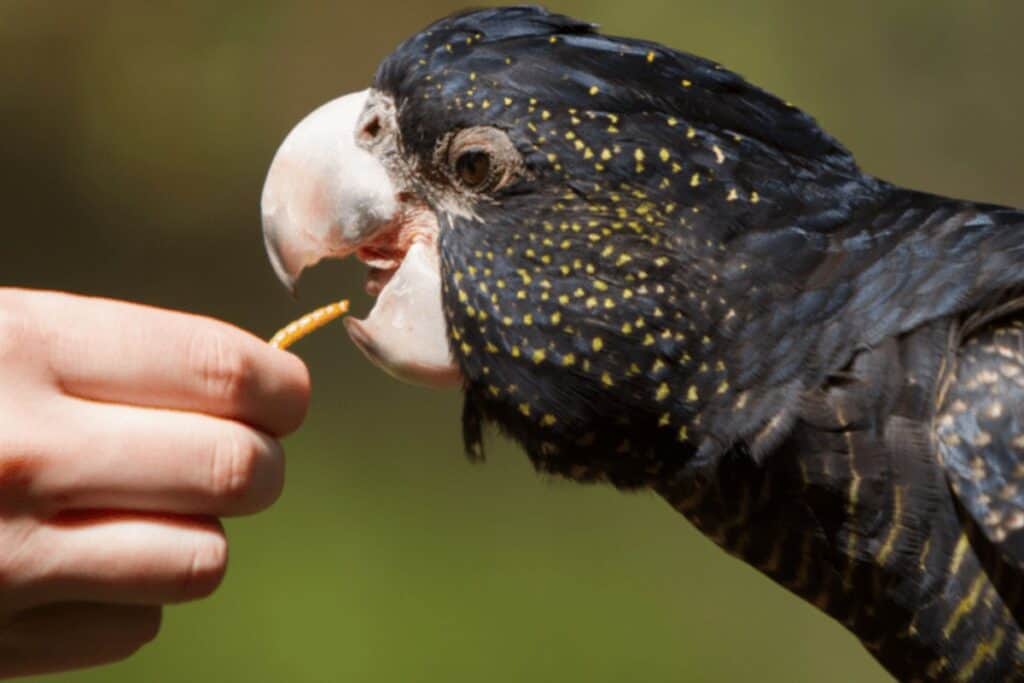
Naming:
| Scientific Name | Red-tailed Black Cockatoo – Calyptorhynchus banksii graptogyne |
| Family | Cacatuidae:Psittaciformes:Aves:Chordata:Animalia |
| Infraspecies author | Schodde, Saunders and Homberger,1989 |
Habitat and Range
The red-tailed black cockatoo mainly inhabits inland regions across much of Australia. Their range includes parts of southwestern Australia, across to South Australia, western Victoria and New South Wales, and into southern central Queensland.
They primarily live in open eucalypt woodlands and forests growing on infertile sandy or rocky soils. Though they occasionally visit coastal areas, they avoid dense wet forests. Red-tailed blacks show preferences for woodlands where the canopy does not grow too thick, made up of open stands of salmon gum (Eucalyptus salmonophloia), gimlet (Eucalyptus salubris), yellow gum (Eucalyptus leucoxylon) and wandoo (Eucalyptus wandoo).
These cockatoos nest in tree hollows, mostly in smooth-barked eucalypts and Corymbia. As they require very large hollows only found in extremely old trees, suitable nesting sites are rare. Mature nest trees are often more than 400 years old. The continuity of these hollow-bearing trees is essential to maintain viable breeding populations.
Red-tailed blacks show seasonal movements based on food availability. In summer they may congregate in tens or hundreds where seed or insect abundance is high. Their mobility allows them to pioneer new habitats, including regrowth in logged and burnt areas. But the overall loss of nesting hollows and foraging habitat has led to the disappearance of red-tailed black cockatoos from parts of the former range. Protecting remaining woodland ecosystems is crucial for the species’ future.
Diet and Feeding
The red-tailed black cockatoo has a specialized diet, feeding almost exclusively on the seeds of native plants. Their main food source is the seeds of Banksia, Hakea, and Grevillea trees and shrubs. The large, sturdy beaks of the red-tailed black are specially adapted to break open woody seed pods and extract the nutritious seeds inside.
To get to the seeds, the cockatoos use a variety of clever feeding techniques. They may perch on seed pods and chew them open, or firmly grip pods in their feet and shred them with the massive beak. Often they will break off branches to get better reach or to place large seed pods in a stable position. The strong prehensile tail is used like a tripod to gain leverage, the bird steadying itself as it rips into the pod. They have even been documented using tools, modifying sticks to rake and lever open pods.
The birds feed primarily in the treetops, foraging through the canopy for seed pods. They may feed alone but more often move together in small family groups. By flocking together and calling to each other, the cockatoos can locate plentiful new sources of food. They remember reliable feeding sites and return year after year to productive trees. To supplement their seed diet they also feed opportunistically on roots, corms, fruits, and insects.
The red-tailed black cockatoo’s specialized penchant for woody seed pods means they play an integral ecological role. As they chew open countless seed pods every year, the cockatoos serve as critical vectors to spread seeds and aid bush regeneration across Australia’s forests and woodlands. The survival of these cockatoos ensures the ongoing propagation of many native plants. Their unique niche in Australia’s ecosystems cannot be filled by any other bird.
[Interesting fact: Unique among Cockatoos, Red-tailed Blacks are known to use tools. They’ve been documented modifying sticks to rake and dig for food.]
Breeding
Breeding Red-tailed blacks form long-lasting monogamous bonds, reinforced by the pair regularly preening each other. They strengthen partnerships with elaborate courtship displays. In a bonding ritual, the male cockatoo periodically regurgitates food for his mate.
Breeding season lasts from March to September. The female typically lays just a single egg per season. Both parents share brooding duties, taking turns incubating the egg over 30-35 days until hatching. After another 10-12 weeks of nestling development, the young chick emerges from the hollow.
The parents share care of the slower-developing young. For up to two years after leaving the nest, the fledged juveniles remain partially dependent within their family group. By participating in rearing subsequent chicks, the older offspring may be learning vital parenting skills.
[Interesting fact: If food gets scarce, red-tail parents may sometimes expel older offspring to ensure adequate provisions for a helpless new hatchling.]
Siblings form especially tight social bonds, foraging and roosting together once independent. As adults, they may continue associating or even team up as cooperative breeding helpers at a chosen sibling’s future nest. These highly social behaviors underpin success in rearing the species’ extremely slow-maturing young.
[Interesting fact: Young cockatoo chicks can gag themselves with their tongues while begging for food from their parents.]
Conservation Status
The magnificent red-tailed black cockatoo is currently listed as endangered. Once more widespread across suitable inland habitats, clearing for agriculture and timber has drastically reduced their range. This habitat loss also severely limits nesting sites—with large tree hollows only found in very old growth.
Competition with overabundant invasive species like galahs and corellas may crowd out red-tails from the remaining habitat. Illegal poaching of chicks for the pet trade has also impacted local populations.
Current population estimates range widely from only 10,000 up to 60,000 total individuals left in the wild. But numbers continue declining and the cockatoos have disappeared entirely from some former range areas. South Australia’s red-tail population is thought to be as low as 1,500 birds.
Conservation efforts now focus on preserving intact woodland ecosystems with protected old hollow-bearing trees. Some private landowners and indigenous communities actively monitor and manage remnant red-tail habitat. Extensive habitat restoration projects aim to recreate suitable feeding and nesting conditions.
Public education campaigns target illegal poaching while raising awareness ensures ongoing political support. Tracking programs elucidate the cockatoos’ movements and needs. Captive breeding initiatives may supply cockatoos to repopulate the restored habitat. With vigorous conservation action, these superb birds can be secured for Australia’s future.
a helpful guide to the key differences between the red-tailed black cockatoo and the glossy black cockatoo and yellow-tailed black cockatoo:
Difference between red-tailed, yellow-tailed and glossy Black cockatoos:
Red-tailed Black Cockatoo characteristics
- Largest species, 50-60cm long
- Found in woodlands and forests of WA, NT, QLD
- Red paneling on tail used as rudder in flight
- Carnivorous diet – borers, grubs, insects
- Nest in hollows of eucalyptus trees
- Form large flocks of 30-40 birds
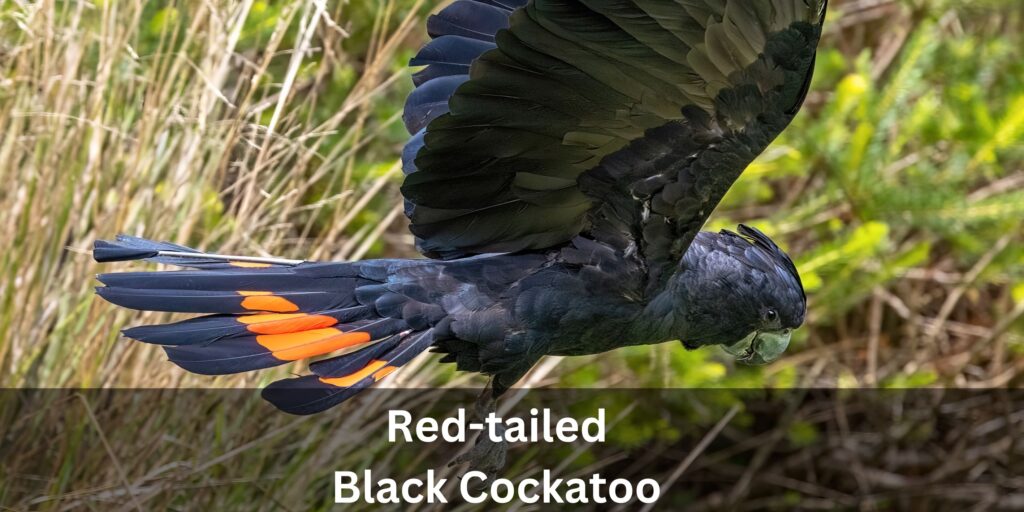
Glossy Black Cockatoo characteristics – Complete guide to Glossy Black here
- Smallest black cockatoo species at 33-36cm
- Inhabits open eucalypt woodlands of SE Australia
- Tail has red bands only visible underneath
- Herbivorous diet – casuarina and she-oak seeds
- Nest in hollows of Allocasuarina trees
- Usually found in pairs or small groups
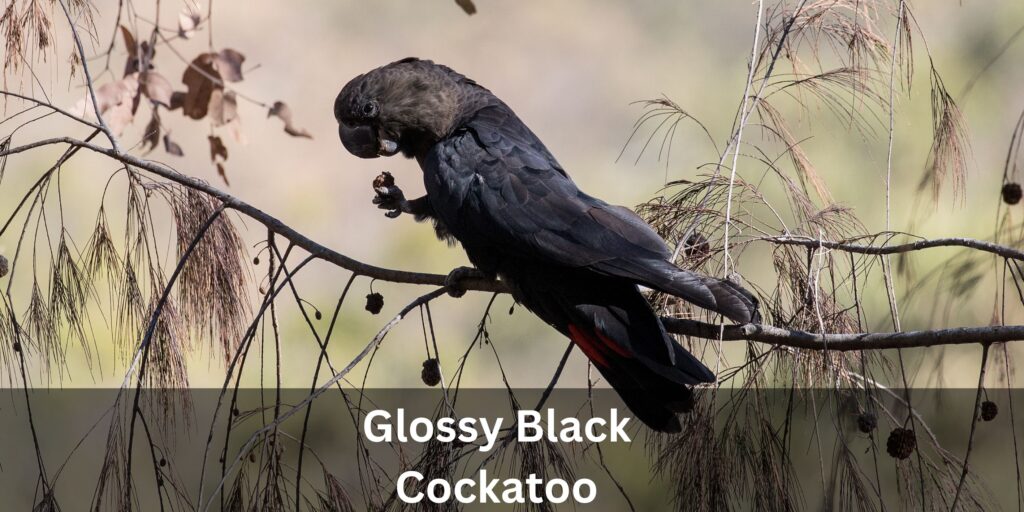
Yellow-tailed Black Cockatoo characteristics
- Medium-sized species, 45-50cm long
- Found in open forests and woodlands
- Bright yellow tail panels provide namesake
- Herbivorous but opportunistic – some insects
- Nest in hollows of large eucalypts
- Congregate in large flocks up to 500 birds
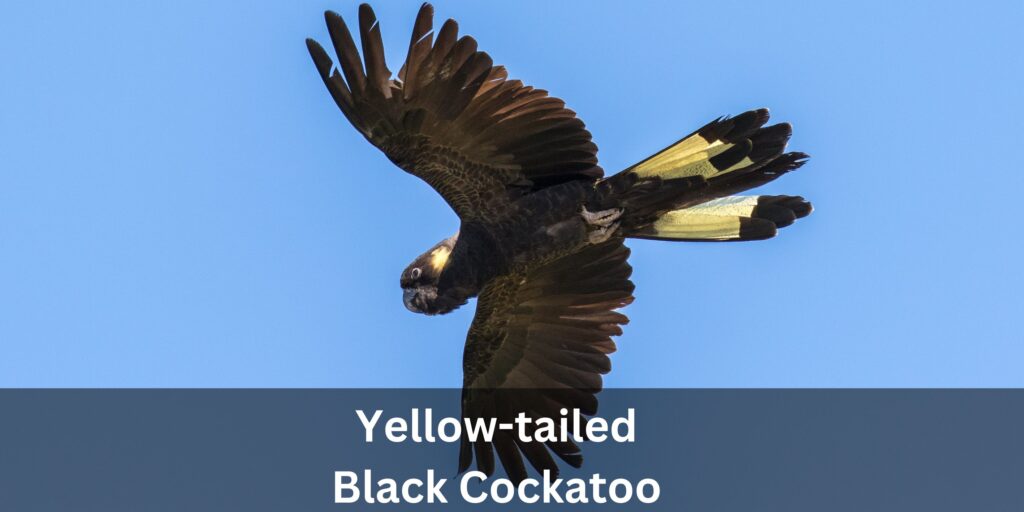
Black Palm Cockatoo Information Here (not in the same family as the 3 Black Cockatoos above)
Scientific Classification
The red-tailed black cockatoo is a member of the bird family Cacatuidae – the family containing all of species of cockatoo.
Within the scientific taxonomic classification system, its full scientific name is:
- Kingdom: Animalia
- Phylum: Chordata Class:
- Aves Order: Psittaciformes
- Family: Cacatuidae
- Genus: Calyptorhynchus
- Species: Calyptorhynchus banksii
This species was first formally described in 1802 by the famed English ornithologist John Latham, honoring the naturalist Sir Joseph Banks by giving the specific epithet banksii.
For many years taxonomists included red-tailed black cockatoos as a subspecies Calyptorhynchus funereus banksii (commonly the short-billed cockatoo). However, in 1986 studies of morphology, ecology and vocalizations found clearly distinguishing features from short-billed populations. This work resulted in again recognizing the red-tailed blacks as a fully distinct species Calyptorhynchus banksii.
Some discussion continues whether anywhere from one to four subspecies of red-tailed black cockatoos should be delineated across various isolated populations. But currently, only a single species C. banksii is officially recognized and given full species status. Ongoing genetic research may help clarify if any distinct subspecies exist within continental wild populations or captivity.
